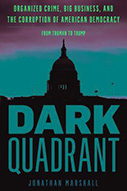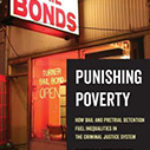Dark Quadrant: Organized Crime, Big Business, And The Corruption Of American Democracy

Author: Jonathan Marshall
Publisher: Lanham, MD: Rowman & Littlefield, 2021. 416p.
Reviewer: Frederick T. Martens | August 2021
As part of an organized crime initiative, I was tasked in 1975 with interviewing Frank Mallamaci, a relatively higher-ranking confidante of Joseph “Bayonne Joe” Zicarelli, a caporegime in the Bonanno mafia family. When questioned about corruption in Hudson County, New Jersey, Mallamaci chose instead to discuss corruption in the White House. “You wanna know about corruption…let me tell you about the time we were running guns to the Dominican (Republic) and were shot at by guerilla forces…we barely made it back to Miami.” Naively I asked him, who commissioned you to bring those guns to the Dominican? “Who do you think,” Mallamaci responded, “the CIA.”
Long before Russia interfered in the 2016 presidential election, the US State and Justice Departments were intimately engaged in subverting the governance and elections of sovereign foreign governments. Jonathan Marshall not only captures the role of the United States in flipping governments throughout the Southern Hemisphere, he exposes unvarnished truths about those who have held the most powerful office in the world. There are few heroes in Marshall’s dark history of twentieth century politics.
In a somewhat twisted sense, one of the overriding themes that becomes apparent in digesting the troves of material presented by Marshall is simply that “sound and responsible policies can emanate from corrupt politicians,” presidents included. Accordingly, then congressional candidate Richard Nixon “…in 1946, allegedly… [was] introduced to the biggest and brashest gambler in all of Southern California: Mickey Cohen…Cohen said he donated $5,000 to the fledging Republican’s first congressional campaign…” (p. 35). Years later, it was President Nixon who extended executive clemency to the late James Hoffa, allegedly for a million-dollar payoff—which was never proven (p. 191). Surely, “Nixon’s collaboration with the criminal underworld reflected his obsession to win at all costs…,” according to Marshall (p. 194). But perhaps ironically, it was Nixon who signed into law the Organized Crime Control Act of 1970, which allowed for the Racketeer Influenced Corrupt Organizations Act (RICO) to be used against Cosa Nostra as well as corrupt political machines (p.178).
Dwight Eisenhower, while campaigning for president in 1952, “pledged” to rid government of the corruption that had been endemic during the Truman era. But once elected, the Eisenhower administration saddled up with Rafael Trujillo, the dictator of the Dominican Republic, who, according to Marshall, not only provided lucrative sugar and mining contracts to members of Eisenhower’s family, but gave unfettered entre’ to Cosa Nostra and its gambling interests (Pp. 40, 83).
Indeed, America’s fascination with Latin America was only heightened by the fact that Cuba, 90 miles off the coast of Florida, was a satellite outpost for the Soviet Union during the height of the Cold War. In 1960, with Eisenhower’s knowledge, says Marshall, “the CIA secretly approved plans to murder the new Cuban dictator [Fidel Castro]” (p. 96).
Cosa Nostra had been given carte blanche by the corrupt Cuban Batista regime that preceded Castro. Renowned mobsters such as Angelo Bruno, Santo Trafficante, Charles Luciano, Carlos Marcello, Sam Giancana, Joe Zicarelli, and Meyer Lansky, all agreed that with the “new Cuban dictator,” their interests in Cuba were short-lived. Working in tandem with Trujillo, and recognizing their financial interests coincided with the political agenda of the United States, enlisting the services of Cosa Nostra was seemingly a fait accompli (Pp. 94-102).
The election of President John F. Kennedy in 1960, and the appointment of his brother Robert Kennedy as attorney general, led to decisions that resulted in the ill-fated Bay of Pigs invasion by CIA-trained Cuban exiles in an attempt to topple Castro. Parenthetically, it also revealed the nefarious alliances among the CIA, Cosa Nostra, and other elements of the Kennedy administration to use whatever tools deemed necessary to prevent the spread of Communism (p. 99). Never before had the omnipotence of Cosa Nostra been so audaciously unmasked. This intrigue ultimately tracked to the assassination of John F. Kennedy, wherein the so-called deep state, Cosa Nostra, and Cuban/Castro operatives were all elements of conspiracy theories about the assassination.
Marshall describes the administration of Lyndon Johnson, who followed Kennedy, as being rife with corruption. This included scandals involving nepotism, inside deal-making that enriched members of the Johnson family, connections to organized crime, and the fact that persons of dubious and irreputable character permeated the administration. Even the renowned Johnson biographer Robert Caro is subjected to Marshall’s rigorous criticism — with the claim that Caro’s “otherwise unshrinking examination of Johnson’s dark side, completely ignores the leading role played by organized crime” in Johnson’s meteoric rise to power. Nonetheless, Marshall appropriately credits Johnson with establishing the “highly successful, geographically targeted ‘strike forces’ to prosecute entrenched local criminal organizations,” as well as the 1967 President’s Commission on Law Enforcement and Administration of Justice that produced the Task Force Report: Organized Crime. It was this publication that established both the theoretical and functional foundation for what is considered to have begun a war on organized crime.
Although President Ronald Reagan (1980-1988) attempted to burnish his crime-fighting legacy by creating the 1983 Commission on Organized Crime, the firing of two “highly-respected [Organized Crime] Strike Force prosecutors,” who were investigating the mob’s influence in the music industry, as well as Reagan’s cozy relationships with the Teamsters Union and the Longshoreman’s Association, both of which were in the throes of Cosa Nostra, seemingly demonstrates the duplicity that often belies political motives and actions.
Certainly not lacking for more contemporary anecdotal material, Marshall traces former President Donald Trump’s pedigree back to his grandfather who “ran a house of prostitution for gold miners in California….” (p. 226). Marshall points out that Trump employed the services of the nefarious and disgraced attorney Roy Cohn, whose extensive ties to the mafia greased the wheels for Trump to pursue his construction projects in the “Big Apple” —a city where the construction trades were and are dominated by organized crime. Indeed, Marshall uses Trump to introduce the reader to what he believes is a new chapter in the metamorphosis of organized crime. “President Trump represents the bridge between the old and new worlds of organized crime,” referring to Trump’s involvement with Cosa Nostra, Russian gangsters and oligarchs.
Only time will tell whether or not Trump was a willing conduit or a “useful idiot” in abetting the transfer of wealth from the former Soviet Union and the gangsters and oligarchs (who may be and often are one of the same) that pillaged the assets of its people. But perhaps even more unsettling is whether the highest levels of the United States government were compromised by these nefarious alliances?
While Marshall dispels any doubt as to organized crime’s insidious and pervasive influence in both business and politics, he is equally as critical of the democratic processes that have “remain[ed] complacent about the deeply corrosive effects of real and perceived corruption, and the self-defeating cynicism it can breed…” Ironically, both Marshall and Donald Trump seem to agree on this point: “As a businessman and a very substantial donor to very important people, when you give, they do whatever the hell you want them to,” Trump boasted while campaigning for the presidency.
Dark Quadrant is a compelling assessment of the political chicanery that has shaped and sculpted America’s political landscape for decades. Meticulously sourced, the author conducts a political autopsy that guts the corpses that lay strewn along the roadways to political success, greatness, tragedy, and scandal. The events, relationships, and conversations sourced from wiretaps and electronic surveillance are real and concrete. They are etched in troves of documents, speeches, memoirs, congressional investigations, and oral histories.
For those who wish to gain an intimate knowledge of the nexus among organized crime, business, and politics, Dark Quadrant is a fascinating and jolting journey into the abyss. There is something for everyone—the organized crime buff, the political scientist, and most certainly, the historian who often gives short shrift to the invisible hand. Simply put, money now and forever has and will rule American politics. The evidence marshalled here proves the case beyond any doubt.
Frederick T. Martens retired from the New Jersey State Police, where he investigated organized crime and corruption. He served as the President of the International Association for the Study of Organized Crime (IASOC).


